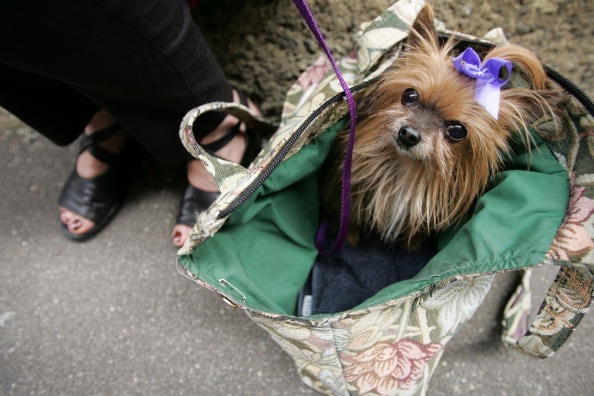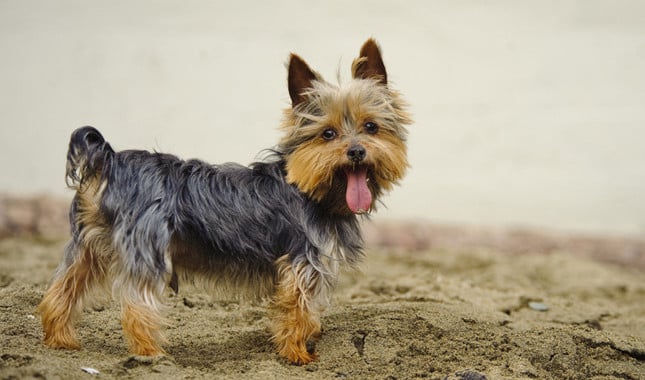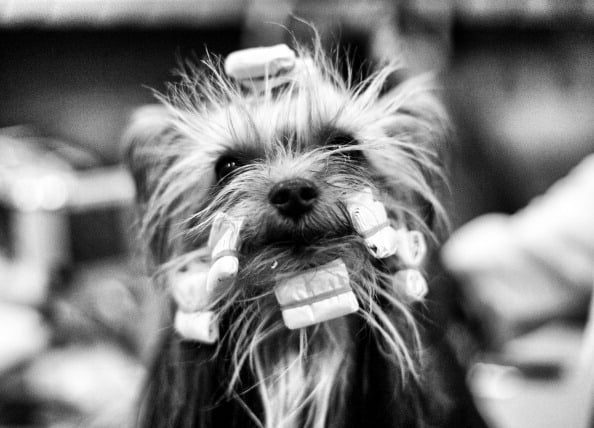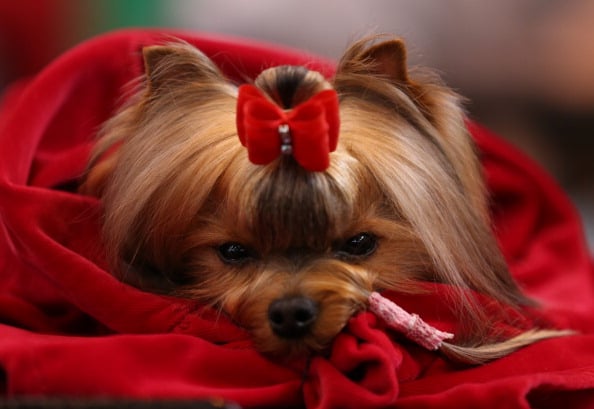1. They Originate from Yorkshire in the 19th Century
Yorkshire Terriers have an interesting history. They were first bred in the county of Yorkshire in England in the mid-19th century. When workers from Scotland came to work in Yorkshire, they brought with them several varieties of small terriers. Details of how the dogs brought to Scotland led to the breeding of the Yorkshire Terrier are vague. It is simply known that they were originally bred by workers in the cotton and woollen mills. A quote by Mrs A. Foster from 1886 explains that reliable breeding information was not kept as the men working in the mills at that time were not well educated and did not have the capacity to record these details accurately.

2. They Were Bred from Three Dogs
One piece of information that is known is that the Yorkshire Terrier is a breed that was created from three different dogs. The first of these was a male called Old Crab. The second was a female called Kitty. The third was a female dog whose name is unknown. During the early stages of breeding, it is believed that the Paisley Terrier and the Maltese were used. While they were bred using terriers from Scotland, they are called Yorkshire Terriers to reflect the area in which this breed was improved. They are now commonly referred to as Yorkies. Originally, the Yorkshire Terrier varied greatly in appearance, but these differences have now been ironed out through breeding. At one point, almost any terrier type dog with a long coat and coat colorings of blue, silver, and tan was referred to as being a Yorkshire Terrier.

3. Yorkshire Terriers Are Classified as a Toy Breed
Yorkshire Terriers are one of the smallest dog breeds in the world. This means they are usually classified as being a toy breed, although some kennel clubs call them companion dogs. The average healthy adult Yorkshire Terrier will grow to between seven and eight inches in height. Most will weigh in the region of seven pounds. This is similar to the average weight of a human baby. Another interesting fact is that this breed has a reasonably long life expectancy as they live on average between 11 and 15 years.
4. They Are the Sixth Most Popular Breed of Dog in the United States
The Yorkshire Terrier has now become the sixth most popular breed of dog in North America. This is according to the American Kennel Club. The Americans love the small size of this dog and its loving nature. The breed is also popular in many other countries in the world, including the UK from where it originates.

5. Huddersfield Ben is a Famous Yorkshire Terrier
There are many famous Yorkshire Terriers throughout history and probably the most famous of these is called Huddersfield Ben. The reason he is so famous is that he set the standard for the breed as we know it today. Huddersfield Ben was a show and stud dog that was owned by a woman called Mary Ann Foster. He was very successful in shows and one authority on dog breeds described him as the best dog of his breed during his lifetime. He had such good traits that he soon became considered the standard for the breed. Huddersfield Ben’s portrait was famously painted by George Earl in 1891. As everyone wanted a dog just like him, he fathered many puppies. He is still often referred to as the father of the breed to this day

6. Some Say They Have a Hypoallergenic Coat
One of the reasons why the Yorkshire Terrier is so popular that it has a hypoallergenic coat. This is because they shed far less than other long-haired breeds of dog as they only usually shed small amounts when brushed or bathed. This is great for people who have allergies to dog hair as they will find very little hair around their homes. If a person is allergic to a Yorkshire Terrier, it is generally their dander or saliva that will trigger a reaction. Some scientists disagree with the statement that the Yorkshire Terrier has a hypoallergenic coat as they argue that dogs have different proteins that can trigger a reaction in some people and not in others. Therefore, the fact that they do not shed may make little or no difference.

7. There is Only One Standard Coat Color
Unlike many other dogs that have several colors that are recognised as being official to the breed, there is only one standard color of coat for the Yorkshire Terrier. The standard color for a Yorkshire Terrier is a tan coat with a blue saddle. However, there are variations of this which are called particolors. A dog that is described as particolor is white with black or blue and tan. This is caused by a recessive gene and is rare. Another variation is a golden coat and these dogs can only produce pheomelanin, while others are chocolate or liver and only produce brown eumelanin. Dogs that are not the standard color often have health problems. It can take between three and four years for the color of a Yorkshire Terrier coat to establish itself. For this reason, there are some who argue that dogs below this age should not be shown in competition as they may not be officially recognized due to the true color of their coat.

8. They Bark a Lot
One personality trait of a Yorkshire Terrier is that they bark a lot. This has given them a reputation for being a yappy dog and to some people this is a negative aspect of the breed. However, others see it as a positive feature of this type of dog. One reason for this is they make an excellent watchdog. It is a well-known fact that the presence of a dog in the home can act as a deterrent against crime. When a dog starts barking if an intruder tries to enter your home, they are less likely to commit the crime as the barking will draw attention to them and make people aware that a crime is about to take place. Therefore, some people will specifically choose a Yorkshire Terrier because they bark and can act as a form of security to their home. Some experts argue that if a Yorkshire Terrier is content, it is less likely to yap unnecessarily.

9. Yorkshire Terriers Are Easy to Train
One of the best advantages of having a Yorkshire Terrier is that they are an intelligent breed of dog and this makes them easy to train. One reason they are so easy to train is that it is in their nature to work well without the need for human assistance. The Yorkshire Terrier was originally bred as a working dog and their nature is suited to following instruction. They are easily motivated by food or praise and are extremely quick to learn. According to Stanley Coren’s book ‘The Intelligence of Dogs’, the Yorkshire Terrier is ranked as 27th in the list of the most intelligent dog breeds.

10. Like Humans, They Have Two Sets of Teeth in a Lifetime
Just like humans and most other dog breeds, a Yorkshire Terrier will have two sets of teeth in a lifetime; their milk teeth and their adult teeth. Their milk teeth, or deciduous teeth, consists of 28 teeth. At first, a puppy will have no teeth and their first teeth will begin to grow between the ages of three and eight weeks old. They will then lose these teeth at about four months of age and the second set will grow. A Yorkshire Terrier will usually have 42 adult teeth. This can sometimes vary but it is not a problem unless it is causes a bad bite. One problem that Yorkshire Terriers have is overcrowding of their teeth because of their small jaws. If this occurs, it can result in poor dental health. They may need professional cleaning by a veterinarian to prevent further health problems.

11. There Are Many Genetic Defects Associated with Yorkshire Terriers
Unfortunately, Yorkshire Terriers are prone to a large number of genetic defects. One of the most common of these is a minor health problem called distichiae. This is where eyelashes grow from an unnatural spot around the eye. This can lead to many other eye problems, including irritation, corneal abrasion, corneal ulcers, and squinting. Another genetic defect found in Yorkshire Terriers is hypoplasia od dens. This is when the pivot point of the second cervical vertebra does not form and leads to damage to the spinal cord. Other potential genetic defects found in Yorkshire Terriers include Legg-Calve-Perthes syndrome, luxating patellas, portosystemic shunt, and tracheal collapse.

12. There Are Some Health Problems to Which Yorkshire Terriers Are Prone
There are also several health conditions to which Yorkshire Terriers are more prone to suffer than other breeds. Some of the most common conditions to which Yorkshire Terriers are prone include cataracts, lymphangiectasia, keratitis sicca, and bronchitis. Hypoglycemia is an additional concern with this breed, especially in puppies. This is because they have low muscle mass and this makes it difficult for their bodies to store glucose. Furthermore, it is common for a Yorkshire Terrier to have a delicate digestive system. If they eat foods outside of their regular diet, they may experience diarrhea and vomiting. The small size of a Yorkshire Terrier can lead to further problems. They have a low tolerance for anaesthesia and this is something that your veterinarian will take into consideration if your pet ever needs surgery. Also, like many other small breeds of dog, they are more prone to injuries from falls, clumsiness, and other dogs. If a Yorkshire Terrier is particularly small or underweight, they are more at risk of developing health conditions and their life span is likely to be significantly shortened.

13. Yorkshire Terriers Are Sometimes Docked
It is common practice in many countries for Yorkshire Terrier puppies to have their tails docked so they are a short stump instead of their natural longer tail. One possible reason for this is to prevent the hair on their tail from dragging on the floor, picking up dirt and getting matted. However, docking is now illegal in many countries, such as the UK, as it is considered cruel and unnecessary. While the practice of docking is illegal in most countries, it is still a requirement of the Canadian Kennel Club and the American Kennel Club and a Yorkshire Terrier must have its tail docked to compete in events. Therefore, if you attend an international dog show, you may see both docked Yorkshire Terriers and Yorkshire Terriers who have their natural longer tails.

14. There Are Several Similar Breeds
There are several breeds of dog that are similar to Yorkshire Terriers and this is usually because they have similar origins. The Yorkshire Terrier was bred form and is similar to the Scottish breeds Paisley Terrier and Skye Terrier, both of which it shared similarities. However, these two breeds are now extinct. The Yorkshire Terrier has been thrown into the gene pool in creating other breeds and these have inherited many similar characteristics. These include the Australian Silky Terrier and the Biewer Terrier. The latter was bred from a blue, white, and gold puppy. It was later named Schneeflocken von Friedheck and was owned by a German couple called Mr. and Mrs. Biewer. People have been willing to pay large sums of money to have a Yorkshire Terrier bred with a dog of another breed in the hope that it will inherit the characteristics of a Yorkshire Terrier. These new breeds of dog are usually named with part of the words Yorkshire Terrier in them to reflect their ancestry. There are two other breeds that are exceptionally similar to the Yorkshire Terrier, but have a shorter coat. These are the related breeds the Norwich Terrier and the Norfolk Terrier; the latter of which is drop-eared.

15. Teacup Yorkies Are an Unofficial Variation of the Yorkshire Terrier
There is a variety of Yorkshire Terrier that is called a ‘Teacup Yorkie’, although these are not recognized by most Kennel Clubs around the world. This includes the American Kennel Club who do not acknowledge this as a variation of the breed. This term is used to describe a Yorkshire Terrier that is exceptionally small. Although the standard weight for an adult Yorkshire Terrier is around seven pounds, a fully-grown Teacup Yorkie is usually under four pounds. This variation of the breed is specifically bred to retina cute features like a puppy with little concern for the health implications of breeding in this manner. Deliberate breeding of a Teacup Yorkie is extremely controversial and is discouraged by responsible breeders. One of the main issues of breeding a Teacup Yorkie is that they are too small to give birth, and this leads to the necessity of a caesarean section. This is potentially life threatening for both the mother and her litter of puppies. Teacup Yorkies are also at greater risk of a variety of health conditions than a standard Yorkshire Terrier. These conditions include seizures, hydrocephalus, chronic pelvic pain syndrome, luxating patellae, open fontanels, and heart disease.

16. A Yorkshire Terrier Has Lived in the White House
There are many famous people who have owned a Yorkshire Terrier and one of these is Tricia Nixon Cox. She is the daughter of former President of the United States, Richard Nixon. Her dog was called Pasha and lived at the White House throughout the presidency of Richard Nixon. Patricia Nixon Cox is not the only daughter of a president to own a Yorkshire Terrier as a dog of this breed is also owned by Ivanka Trump, eldest daughter of current President of the United States Donald Trump. The Yorkshire Terrier remains a popular breed amongst celebrities as there are many more people who have owned one of these dogs as a pet. Some of these include Paris Hilton, Miley Cyrus, Carmen Electra, Heather Locklear, Natalie Portman, Donny Osmond, and Miranda Kerr.

17. A Yorkshire Terrier Called Smoky Was a Famous War Dog
It is well-known that various breeds of dog supported the war efforts of World War II. The Yorkshire Terrier was just one of these breeds. The most famous Yorkshire Terrier to serve in World War II was a dog called Smoky. She was a war dog that was considered a hero of World War II. Smoky was owned by William Wynne from Cleland, Ohio. The war veteran had adopted the dog while he was serving in the Pacific for the 5th Air Force for the United States. Smoky weighed just four pounds and stood at only seven inches tall. Despite this, she was a brave dog and faced many dangerous situations. She also faced primitive conditions, humidity, and equatorial heat. At the end of the war, she returned to the United States with Wynne. She died in 1957 at the age of 14 and was buried in an ammo box at Cleveland Metroparks at the Rocky River Reservation in Lakewood, Ohio. At her resting place, there is now a life-size bronze sculpture of Smoky sitting on top of the helmet of a G.I.

18. There Are Yorkshire Terrier Gatherings in New York City
As the Yorkshire Terrier is such a popular breed of dog, it is no wonder that there are various clubs across the globe for fans and owners of this breed. These often meet up for what are called ‘Yorkie Gatherings’. to talk about the breed and introduce their dogs to each other. One area where this is particularly common is in New York City as there is a high concentration of Yorkshire Terrier dogs in this city in comparison to other cities. One possible reason for this is that New York City is very built up and those who live there tend to live in apartments or condos and have very busy lives. This means that the Yorkshire Terrier is the perfect breed of dog for them to keep due to their small size.

19. They Were Introduced to North America in 1872
It was not long after this breed was first created that they travelled to the other side of the Atlantic. They were first introduced to North America in 1872. The first Yorkshire Terrier that was officially registered with the American Kennel Club was in 1885 and this was a female dog called Bella. It was a popular show dog and pet in North America during the Victorian era. The popularity of the breed briefly dipped during in the 1940s as the trend grew away from having small dogs as pets. However, their popularity soon returned.
20. The Smallest Recorded Dog in History Was a Yorkshire Terrier
There are many notable Yorkshire Terriers throughout history that each have a claim to fame for different reasons. One dog of this bread even made it into world record books because she was the smallest dog ever recorded in history. This dog was called Sylvia and she was owned by Arthur Marples who lived in Blackburn, England. She was compared to the size of a matchbox and could easily fit into your pocket. It is recorded that she measured just 2.5 inches high at the shoulder and was only 3.5 inches long from the tip of her nose to the end of her tail. Sylvia also weighed just four ounces.